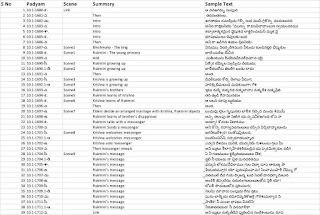Potana’s Rukmini Kalyanam - An Intro
Introduction:
The Story:
The Storyteller:
Not to trivialize, neither Potana nor the message, “Rukmini Kalyanam” is almost like a good matinee movie of Tollywood. Some of Potana techniques in narrating an engaging story are used in Telugu movies. Read it and you won't be disappointed. I was introduced to it 15 years ago in a book club (Detroit Telugu Literary Club). That time I did not understand why everyone was going gaga about the story and poetry. It took me around 2-3 years, on and off, to understand and appreciate. Since then, I am hooked on to it. Now, I often reach out to this as a comfort read. You can even listen (eemaata.com) it in audio form by Sri Juvvadi Gowthamarao. Sri Chimalamarri Brindavanarao describes a verse (10.1-1727-మ.) in detail here (eemaata.com).
Movie Adaptation:
Other Adaptations:
Screenplay:
Potana’s Bhagavatam (1450 - 1510) has 12 chapters. Tucked away at the end of Chapter 10.1 is a 140-verse story (verses 10.1-1680-క. through 10.1-1792-గ., scenes 189through 198, ), popularly referred as “Rukmini Kalyanam”. [Promo: You can download an android app by CharvitaApps, “Potana Bhagavatam” and search for “10.1-1680-క.” to jump right to the story.]
The Story:
The story starts with Rukmini (రుక్మిణి) being born in the house of Bhishmaka (భీష్మకుండు, Not to be confused with Bhishma, Pitamaha of Kauravas). She grows up and develops affection towards Krishna, whom she has never met. Rukmini’s eldest brother is Rukmi (రుక్మి - Notice the similarity in name). Elders decide on having Rukmini married to Krishna. Rukmi opposes and decides his friend Sisupala is more suitable for Rukmini. Rukmini sends a messenger to Krishna. Krishna receives the message, arrives on the eve of wedding and takes Rukmini away. Rukmi chases and a fight follows. Rukmi loses. Rukmini pleads for her brother’s life. Krishna shaves Rukmi’s head as a token of embarrassment. Balarama scolds Krishna and consoles Rukmini. The story ends with Krishna and Rukmini getting married and living happily ever after.
The Storyteller:
Potana does a spectacular job of composing a nava-rasa story within 142 verses. If you take out 10-15 - intro verses, linking verses, ending verses, he is left with only 130 verses. Within these 130 verses he tells a story that is visual and engaging. He is like a cameraman, director, screenplay writer, editor blended into one. He does “juxtaposing” shots between Rukmini and Krishna as they are growing up, “close up” and “trolley” shots when Rukmini is sad, “aerial shots” when Rukmi comes chasing, a fast-paced “editing” when Krishna defeats Rukmi in battlefield and some preaching at the “climax” and of course a “subham card” at the end with the wedding.
Not to trivialize, neither Potana nor the message, “Rukmini Kalyanam” is almost like a good matinee movie of Tollywood. Some of Potana techniques in narrating an engaging story are used in Telugu movies. Read it and you won't be disappointed. I was introduced to it 15 years ago in a book club (Detroit Telugu Literary Club). That time I did not understand why everyone was going gaga about the story and poetry. It took me around 2-3 years, on and off, to understand and appreciate. Since then, I am hooked on to it. Now, I often reach out to this as a comfort read. You can even listen (eemaata.com) it in audio form by Sri Juvvadi Gowthamarao. Sri Chimalamarri Brindavanarao describes a verse (10.1-1727-మ.) in detail here (eemaata.com).
Movie Adaptation:
In the movie, Sri Krishna Pandaveeyam (1966), the story of “Rukmini Kalyanam” has been adapted to the screen. It starts after an hour into the movie with several of Potana’s verses used as-is. It ends at the stroke of intermission. There is no “Narada” in the Potana’s version but introduced into the movie for ease of story telling.
Other Adaptations:
- A pooja adaptation. Potana’s poetry has been translated into prose and pre-pended with a pooja ritual.
- A 4-minute, children’s story telling adaptation.
- Pravachanams have more of devotional and message focus. [A caution, If you search on Youtube, there are Non-Potana versions in Sanskrit, Tamil and others.]
Try Potana’s Rukmini Kalyanam. It might be hard initially but it will grow on you. It is well worth it. It is a comfort read for me. You might like the hidden message. Your choice.
Screenplay:
Anyway, here is the detailed verse-by-verse “screenplay”. Click each image for details.




Comments
Post a Comment